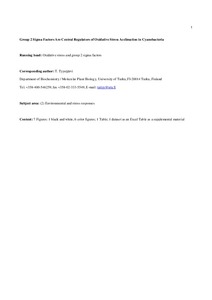Group 2 Sigma Factors Are Central Regulators of Oxidative Stress Acclimation in Cyanobacteria
Hakkila Kaisa; Valev Dimitar; Antal Taras; Tyystjärvi Esa; Tyystjärvi Taina
Group 2 Sigma Factors Are Central Regulators of Oxidative Stress Acclimation in Cyanobacteria
Hakkila Kaisa
Valev Dimitar
Antal Taras
Tyystjärvi Esa
Tyystjärvi Taina
Oxford University Press
Julkaisun pysyvä osoite on:
https://urn.fi/URN:NBN:fi-fe2021042612422
https://urn.fi/URN:NBN:fi-fe2021042612422
Tiivistelmä
Regulatory σ factors of the RNA polymerase (RNAP) adjust gene expression according to environmental cues when the cyanobacterium Synechocystis sp. PCC 6803 acclimates to suboptimal conditions. Here we show central roles of the non-essential group 2 σ factors in oxidative stress responses. Cells missing all group 2 σ factors fail to acclimate to chemically induced singlet oxygen, superoxide or H2O2 stresses and lose pigments in high light. The SigB and SigD are the major σ factors in oxidative stress whereas SigC and SigE play only minor roles. The SigD factor is upregulated in high light, singlet oxygen and H2O2 stresses, and overproduction of the SigD factor in the ΔsigBCE strain leads to superior growth of ΔsigBCE cells in those stress conditions. Superoxide does not induce the production of the SigD factor but instead SigB and SigC factors are moderately induced. The SigB factor alone in ΔsigCDE can support almost as fast growth in superoxide stress as full complement of σ factors in the control strain but an overdose of the stationary-phase-related SigC factor causes growth arrest of ΔsigBDE in superoxide stress. Drastic decrease of the functional RNA polymerase limits the transcription capacity of the cells in H2O2 stress, which explains why cyanobacteria are sensitive to H2O2. Formation of RNAP-SigB and RNAP-SigD holoenzymes is highly enhanced in H2O2 stress and cells containing only SigB (ΔsigCDE) or SigD (ΔsigBCE) show superior growth in H2O2 stress.
Kokoelmat
- Rinnakkaistallenteet [27094]
